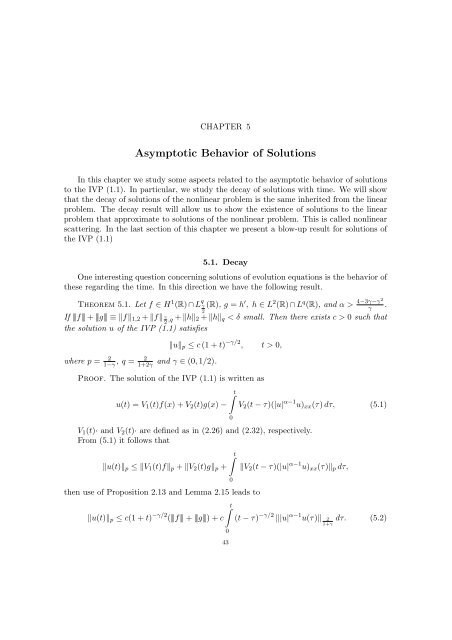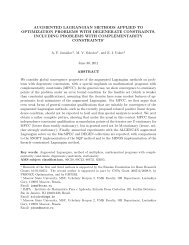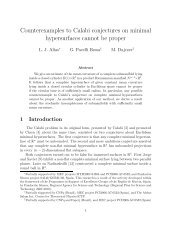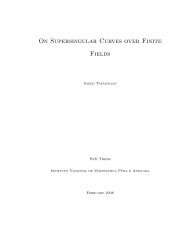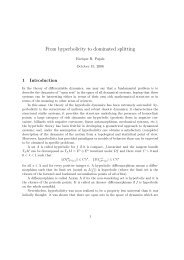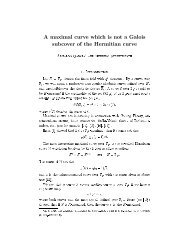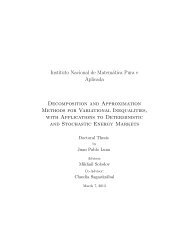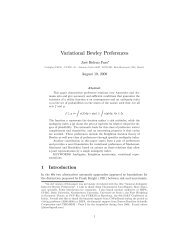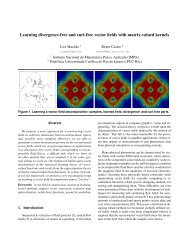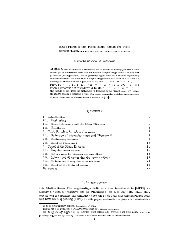Notes on Boussinesq Equation
Notes on Boussinesq Equation
Notes on Boussinesq Equation
You also want an ePaper? Increase the reach of your titles
YUMPU automatically turns print PDFs into web optimized ePapers that Google loves.
CHAPTER 5<br />
Asymptotic Behavior of Soluti<strong>on</strong>s<br />
In this chapter we study some aspects related to the asymptotic behavior of soluti<strong>on</strong>s<br />
to the IVP (1.1). In particular, we study the decay of soluti<strong>on</strong>s with time. We will show<br />
that the decay of soluti<strong>on</strong>s of the n<strong>on</strong>linear problem is the same inherited from the linear<br />
problem. The decay result will allow us to show the existence of soluti<strong>on</strong>s to the linear<br />
problem that approximate to soluti<strong>on</strong>s of the n<strong>on</strong>linear problem. This is called n<strong>on</strong>linear<br />
scattering. In the last secti<strong>on</strong> of this chapter we present a blow-up result for soluti<strong>on</strong>s of<br />
the IVP (1.1)<br />
5.1. Decay<br />
One interesting questi<strong>on</strong> c<strong>on</strong>cerning soluti<strong>on</strong>s of evoluti<strong>on</strong> equati<strong>on</strong>s is the behavior of<br />
these regarding the time. In this directi<strong>on</strong> we have the following result.<br />
Theorem 5.1. Let f ∈ H 1 (R) ∩ L q γ (R), g = h ′ , h ∈ L 2 (R) ∩ L q (R), and α > 4−3γ−γ2<br />
γ<br />
.<br />
2<br />
If ||f||| + ||g|| ≡ ‖f‖ 1,2 + ‖f‖γ<br />
2 ,q + ‖h‖ 2 + ‖h‖ q < δ small. Then there exists c > 0 such that<br />
the soluti<strong>on</strong> u of the IVP (1.1) satisfies<br />
where p = 2<br />
1−γ , q = 2<br />
1+2γ<br />
‖u‖ p ≤ c (1 + t) −γ/2 , t > 0,<br />
and γ ∈ (0, 1/2).<br />
Proof. The soluti<strong>on</strong> of the IVP (1.1) is written as<br />
∫ t<br />
u(t) = V 1 (t)f(x) + V 2 (t)g(x) −<br />
V 1 (t)· and V 2 (t)· are defined as in (2.26) and (2.32), respectively.<br />
From (5.1) it follows that<br />
∫ t<br />
‖u(t)‖ p ≤ ‖V 1 (t)f‖ p + ‖V 2 (t)g‖ p +<br />
then use of Propositi<strong>on</strong> 2.13 and Lemma 2.15 leads to<br />
∫ t<br />
‖u(t)‖ p ≤ c(1 + t) −γ/2 (||f|| + ||g||) + c<br />
0<br />
43<br />
0<br />
0<br />
V 2 (t − τ)(|u| α−1 u) xx (τ) dτ, (5.1)<br />
‖V 2 (t − τ)(|u| α−1 u) xx (τ)‖ p dτ,<br />
(t − τ) −γ/2 ‖|u| α−1 u(τ)‖ 2 dτ. (5.2)<br />
1+γ


